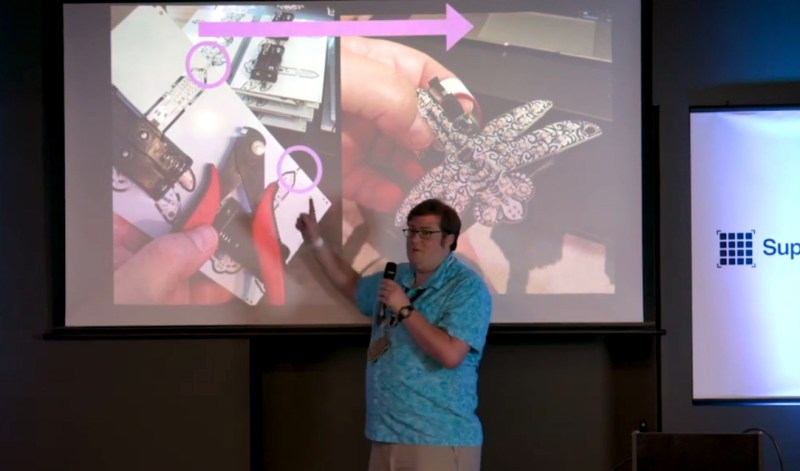If you want to build hundreds of a thing (and let’s face it, you do) now is a magical time to do it. Scale manufacturing has never been more accessible to the hardware hacker, but that doesn’t mean it’s turn-key with no question marks along the way. The path is there, but it’s not well marked and is only now becoming well-traveled. The great news is that yes, you can get hundreds of a thing manufactured, and Kerry Scharfglass proves that it’s a viable process for the lone-wolf electronics designer. He’s shared tips and tricks of the manufacturing process in a prefect level of detail during his talk at the 2018 Hackaday Superconference.
Kerry is the person behind the Dragonfly badge that was sold at DEF CON over the last two years. Yes, this is #badgelife, but it’s also a mechanism for him to test the waters for launching his own medium-run electronics business. And let’s face it, badge making can be a business. Kerry treats it as such in his talk.
After creating 100 badges for DC25 back in 2017 he set a goal in 2018 to bump that number to 500, to use an overseas assembly house to take the process off of his kitchen table, and to come in with a sales price that was 3x the cost of goods sold. He achieved all of this and learn an amazing amount in the process.
This talk is a masterclass in judging tradeoffs during the design process. With 48 RGB LEDs on each of the 500 badges, Kerry was planning to source 25,000 LEDs. With that multiplier, price matters… a lot! He walks through his process which involved surveying available parts to select the most common footprint and pin alignment to ensure he had options if one supplier flaked on him. Speaking of that, he discusses “hedging” on the parts order by ordering in advance to make sure the world supply of a part isn’t yanked out from under you. At these scales, that is certainly a concern.
 Also interesting is his cost-benefit analysis of a few different aspects of the project. After spending 20+ hours on PCB routing he moved from a 4-layer to a 6-layer board. That added $130 to the total cost of the project, but it saved him hours he spent on LED animations instead. The customer cares about those animations, not about the number of layers. He also discusses 2-sided assembly at this scale. For one board, it would have cost an additional $58, but at 500 it’s just $0.10 per unit (that’s $50 more for the entire run of $500). Making this choice means easier layout and the ability to make a more artistically governed front face of the badge.
Also interesting is his cost-benefit analysis of a few different aspects of the project. After spending 20+ hours on PCB routing he moved from a 4-layer to a 6-layer board. That added $130 to the total cost of the project, but it saved him hours he spent on LED animations instead. The customer cares about those animations, not about the number of layers. He also discusses 2-sided assembly at this scale. For one board, it would have cost an additional $58, but at 500 it’s just $0.10 per unit (that’s $50 more for the entire run of $500). Making this choice means easier layout and the ability to make a more artistically governed front face of the badge.
Watch the video, it’s a wealth of knowledge, then come back here and leave a comment thanking Kerry for putting so much care into sharing the story of this product cycle. When we talk about Supercon being the Ultimate Hardware Con, these are the kinds of talks that get us there!
In total, Kerry put about 460 hours of work into producing 460 working Sympetrum-v3 badges. He registered about $14,000 of profit which works out to around $30 per hour for his labor. What I’m still stuck on is the time sink of about 10.25 full-time work weeks. Now that’s #badgelife.
















Should that be “time sync” as in synchronizing time or “time sink” as in time drain like water down a sink?
Yes indeed, fixed.
Very informative! Kerry seems like a cool guy. I laughed so many times watching this.
I agree, entertaining and informative and now I want to make badges too!
I really enjoyed this video and talk. I learned so much. Now to apply what I’ve learned. :-)
Great presentation! I’m glad I saved this to watch later in it’s entirety. I’d love to see more of this. Like with further success or fundraising a trip to the factory to see how the logistics are handled on their side would be interesting to see.